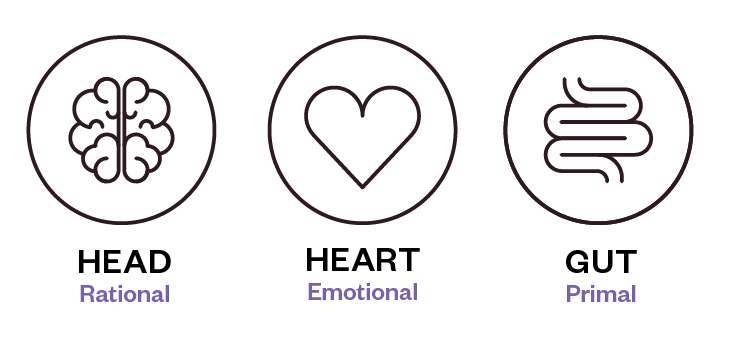For years, it’s been clear that the expectations of B2B enterprises are changing: their customers are younger, brand-savvy and expect seamless, digital experiences. But how well are B2Bs meeting the moment? Nathan Hendricks, Chief Creative Officer at LPK, takes stock.
The B2B world is experiencing a brand-new change in their selling process. Once known for their buttoned-up cultures and button-down collars, these historically sales-driven enterprises have begun to adopt the emotional tools of brand-building to stay competitive and grow their business. Given our own caseload and the immense amount of headline activity popping up around this topic, we have determined the change is here to stay.
This is the moment to adopt this change as a modern B2B brand. We believe it is a good time to better define what we’re seeing, why we’re seeing it and how professionals in this space can acclimate.
Selling vs. Branding
In the past, B2Bs have relied on a well-oiled sales organization to drive sales and business growth. Sales professionals employed lead discipline and people skills to build relationships and generally be in the right place at the right time when a customer is ready to buy. In this way, sales teams often become the main face of their company, and thus carry the weight of the company’s reputation.

But changes in customer behavior are requiring modern B2Bs to act more like B2Cs, rethinking traditional sales approaches and starting from a place of deep discovery on their customers’ wants and needs. Successful organizations are complementing sales activations with modern brand-building to expedite sales cycles, soften the top of sales funnels, create consistency and synchronicity from rep to rep and, ultimately, invest in long-term growth. Fortune 50 company and LPK client, ADM, called on us to reimagine their corporate identity and communication strategy after a major growth expansion. We unified their brand behind a single global mission by streamlining design systems and communications to appeal to diverse audiences in a way they had not been able to do before. In turn, the elevation of ADM’s commitment to people, the planet and a better quality of life allowed customers to better resonate with the company.
So, what happened?
Well, Millennials happened. Long garnering attention for their impact on the consumer economy, they’ve now attained decision-making power in the world of B2B. According to Forrester research, Millennials are the main decision-makers when it comes to purchasing and are expected to make up 75% of business buying teams this year. Their choices are being influenced by a set of sensibilities long associated with this group:
- Digitally native (or close to it)
- Social media adroit
- Financially concerned
- Values-driven
- Work/life blending
- Experientially motivated
- Socially conscious
These sensibilities are producing new buying behaviors and, similar to the scramble made by consumer brands over a decade ago, B2B brands need to overcome their institutional inertia to catch up to their customers. So, let’s catch up.
They do the research. Digitally.
When you’ve grown up with search engines, research is second nature, whether for an English essay or a sneaker purchase. This behavior has dramatically changed the level of information required to begin a purchase journey, as well as when, where and how information is accessed. Millennials try to avoid in-person interaction as much as possible when it comes to the purchase process. The B2B House found that 77% of B2B customers say they do extensive online research before making a purchase. The company sales rep is now the #4 source of information for a company’s product. If a charismatic sales force is your secret sauce for business growth, it’s likely become rather bland. Touchpoints like demos (the #1 source of info), websites and social media channels have knocked reps out of the top spot—and if yours aren’t brand-aligned, you’re missing out on a huge competitive advantage.
They live in a digitally interconnected world.
From grocery shopping to WFH presentations, the modern B2B customer lives a primarily digital existence, so B2B brands should too. They always have their digital device on standby making communication faster, easier and more frequent than ever. According to Demand Sage, 60% of B2B buyers make their final purchase decisions based solely on digital content. Clearly, it’s vital for B2Bs to have a modernized brand that’s optimized for our interconnected digital world.
They’re comfortable buying big-ticket items online.
Being digitally native doesn’t stop at search engines. This group has grown up in a world of increasingly sophisticated e-commerce and they are more comfortable with purchasing bigger online ticket items than their older colleagues. One survey found that 70% of B2B buyers are comfortable spending as much as $50,000 without the assistance of a company representative. But it’s key to remember that Millennials are financially prudent, having faced economic hardships in their lifetime. They take time weighing their options, but in turn, The B2B House is calling for 35% growth in online B2B sales this year.
They expect impeccable customer experiences.
For a cohort accustomed to the work/life blur, CX that redefines expectations is now a basic expectation. Their patience for mediocrity in the products and services they buy is extremely low. According to a study conducted by McKinsey & Company, focusing on customer experience can increase revenue by 5% to 10%. And when they experience great service, they stay, hence the emergent business of subscription services. Consumers sign up for recurring services allowing for a steady source of revenue for the company. Investing in impeccable, brand-driven CX presents a huge opportunity for B2Bs to not only delight on customers but also to do to their competition what ride-hailing apps have done to taxicabs.
They care about brand purpose and values. Immensely.
Way back in 2019, we lived in a world where companies entertained the desires of a subset of passionate employees to address various corporate social responsibility (CSR) issues. Committees were formed. Reports were published. Recommendations were issued and a fragment of those recommendations were acted upon.
By 2021, a lack of tangible action on these plans had real potential to kill deals. Remember, this group has next-level research skills, they’re values-driven and social media-adroit (where the corporate laundry gets aired first and loudest). Purpose-washing was no longer a strategy. These professionals genuinely care about carbon footprints, where products come from and how workers are treated. They require authentic action that is part of a brand’s DNA.
Now in 2024, Millennials are acting on their values in a way no generation has done before. According to a study conducted by Deloitte, 89% of Millennials say having a sense of purpose is very or somewhat important to their overall job satisfaction. This group will turn down projects or job opportunities if it does not coincide with their beliefs. Authentic was the Merriam-Webster word of 2023 while Connection is the word of 2024, so the world alike is craving genuine interactions in both business and personal life.
Brands Matter
Customers are people and people are complicated. They have hopes, dreams and aspirations that they bring to work. Millennials—having grown up in a culture drenched in brands—are more likely than their older coworkers to use brands to attain aspirations and build personas in their professional lives.
It’s important to remember that brands are more than a collection of rational benefits. At LPK, we use a model based on the heads, hearts and guts of consumers. These are a colloquial expression of the rational, emotional and primal reasons people buy brands.

Connecting at all three points is crucial because Millennials are often aiming to build innovative reputations within their organizations and they’re using brands and their new-found purchasing power to do it. B2Bs that insist upon clinging to bulleted listicles of rational benefits run the risk of appearing dusty and staid.
B2C CRM + B2B Marketing
B2B marketing is really no different from B2C CRM—they just operate in different sectors. Selling to both companies and consumers is comparable because they are all humans with the same desires and problems to be solved. B2C and B2B marketing both require a customer-centric sales process and enhanced customer service. Both are required to nurture relationships, so why not meet customers where they wish by becoming more personable and authentic?
A Brand’s Place in the Sales Funnel
As noted above, Millennials are brand-savvy and they’re bringing a more B2C-style sensibility to the B2B world. Unfortunately, in many B2B cultures, this sensibility can come off as fluffy and superfluous BS—all art, no science. In actuality, that fluffy stuff is the collection of attributes that engages the whole brain of your potential customer (not just the left half). It’s also akin to the persuasive charisma your sales team brings to customer interactions—interactions that decision-makers want less and less to do with. This is where brand-building can pick up the slack and make the lives of a B2B sales force easier.

A well-designed brand engages customers earlier in the decision journey, reframing products in new, more resonant ways and helping them think differently about their challenges. By the time customers are ready to act and engage with a company representative, affinity is created and much of the decision-making has already been accomplished.
Margins + Price Sensitivity
In the B2B world, obsessive attention is given to driving more leads and increasing sales volume. Leads and sales can be tracked with numbers. Numbers are sexy. (At least to this crowd.) Measuring brand value and its contribution to sales totals is a dark art at best. However, as Professor Mark Ritson explains, research consistently shows that strong brands command a higher price point, reducing price sensitivity with customers. This is important because a 1% increase in sales volume delivers a 3% increase in profitability—but a 1% increase in price delivers a 10 % increase in profitability.

As Warren Buffet says, “The single most important decision in evaluating a business is pricing power.”
Shareholder Value
The ways in which companies are valued are similar to those of a professional athlete’s contract—based on expectations of future performance. McKinsey estimates that 80% of the value of a stock is based on sales 10-plus years in the future.
At LPK, we define a brand as the promise of an experience or more accurately, the promise of the next experience. The B2Bs that invest in brand-building are the ones more likely to enjoy the benefits of an assumption of future performance. Additionally, strong brands are not only awarded higher stock prices, but they are also imbued with a high degree of resilience. This has been notable in the recent post-COVID years where the top brands in the Brand Z index have remained resilient with their total brand value rebounding by 20% post-COVID. These strong brands demonstrated that meaningful, different and remarkable brands weather economic disruptions effectively.

Parting Advice
Invest in your brand. More importantly, start brand-ing. Identify the higher-order promise your brand offers customers and put it into action across every aspect of your business. Connect on a head, heart and gut level. When you do, your brand can amplify the efforts of your sales team, strengthening the connection between your business and your customers.
Want to discuss how you can use brand to strengthen your B2B and better connect with customers? Reach out to Nathan to start a deeper conversation or contact LPK for a branding workshop.







